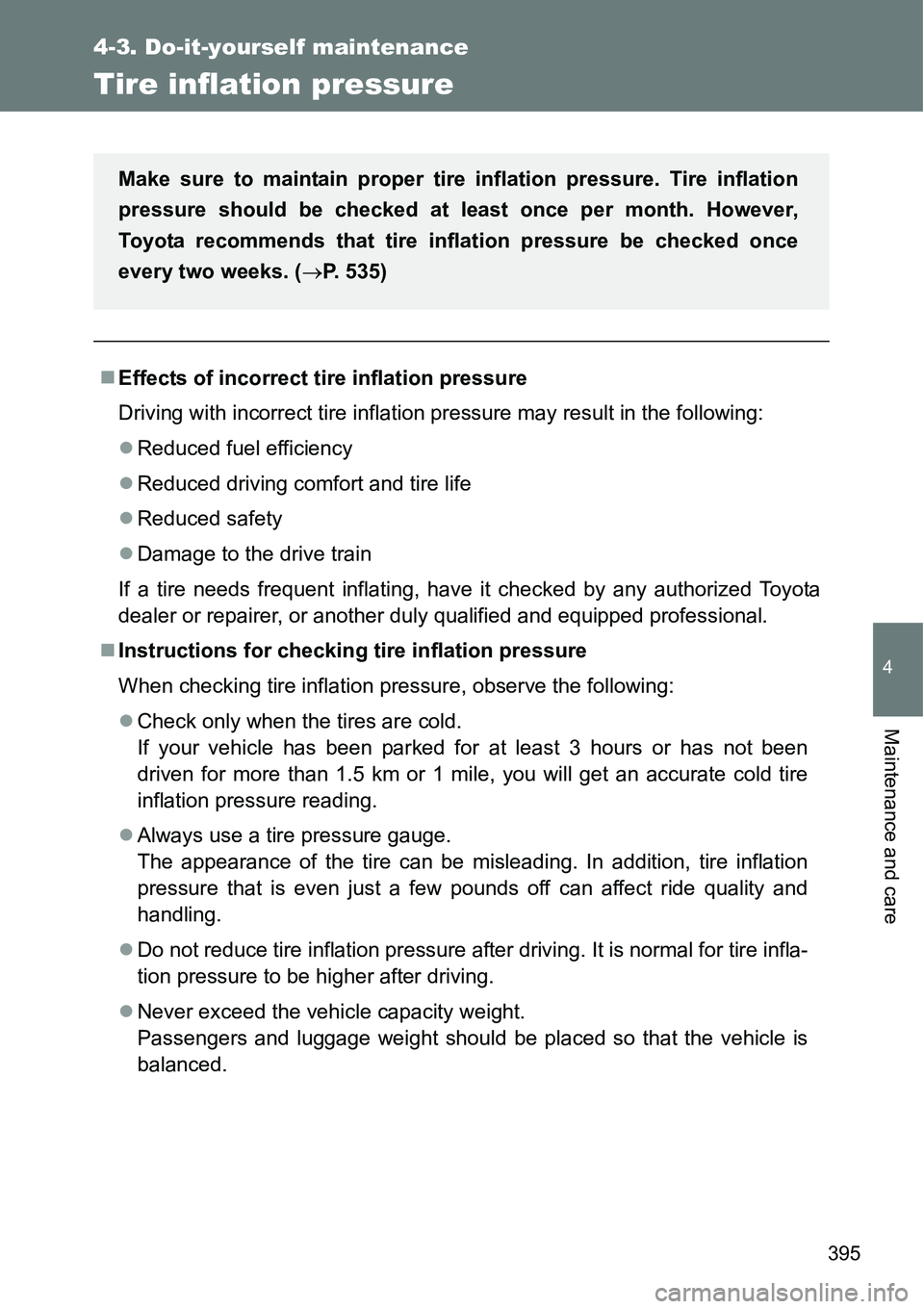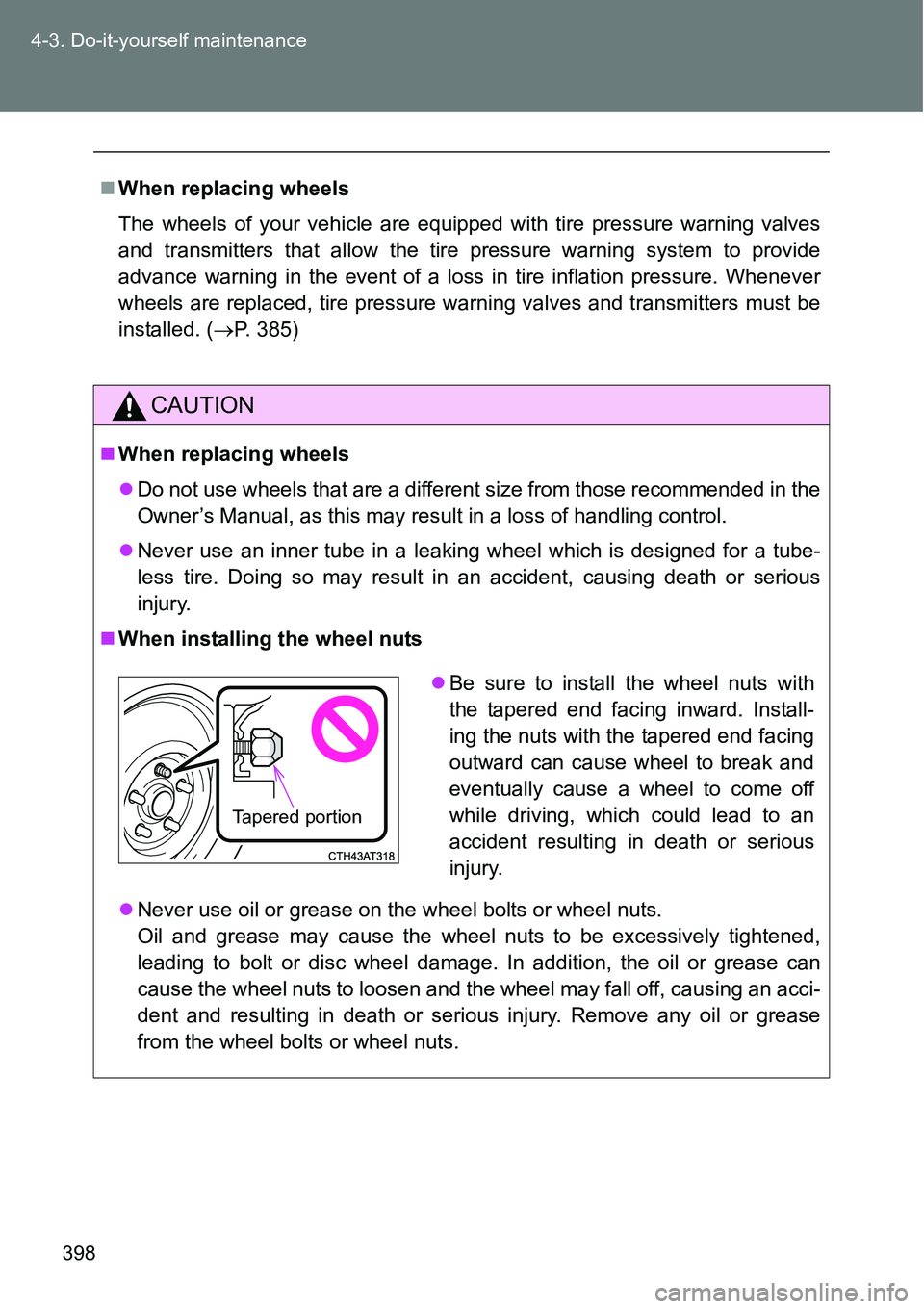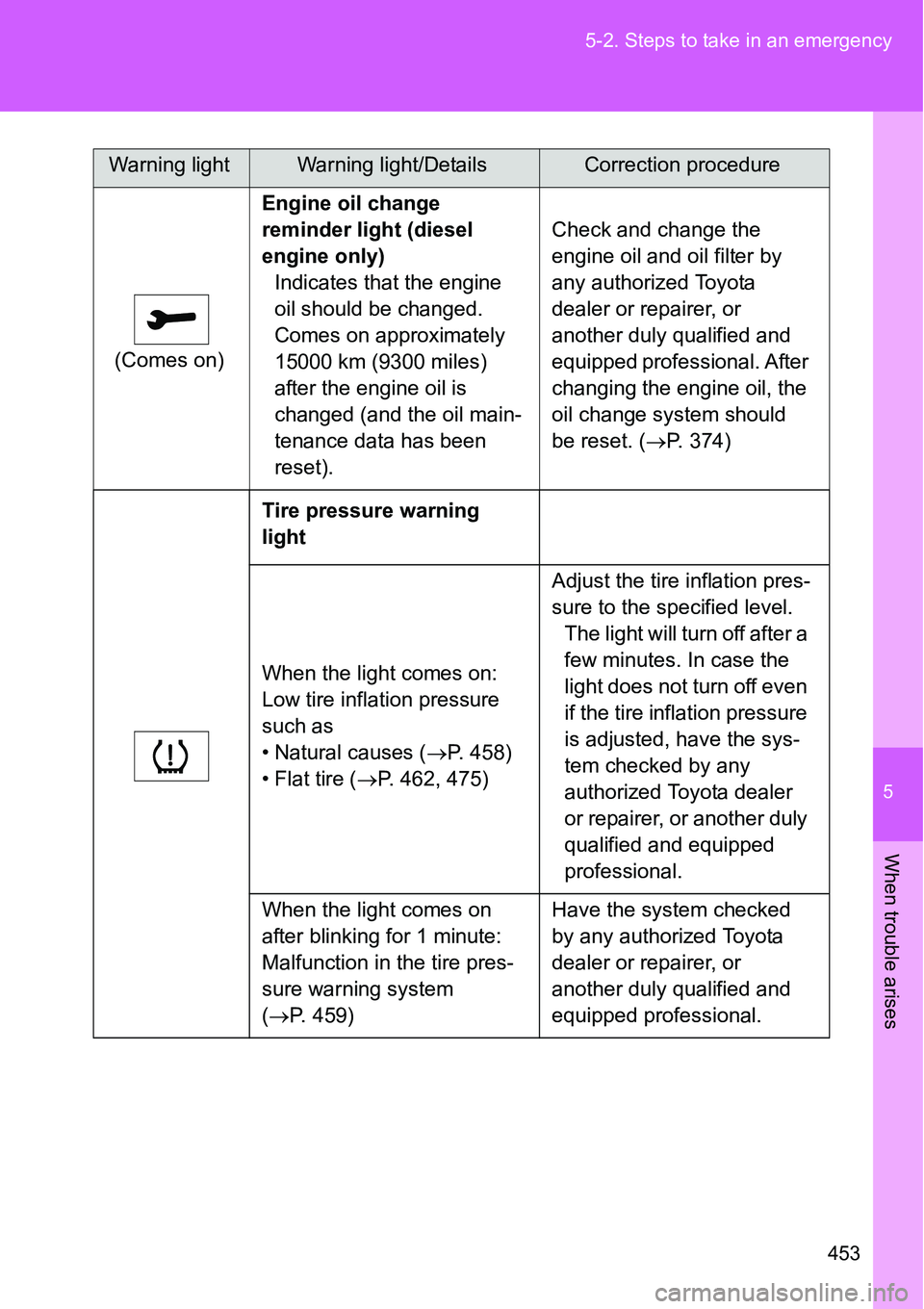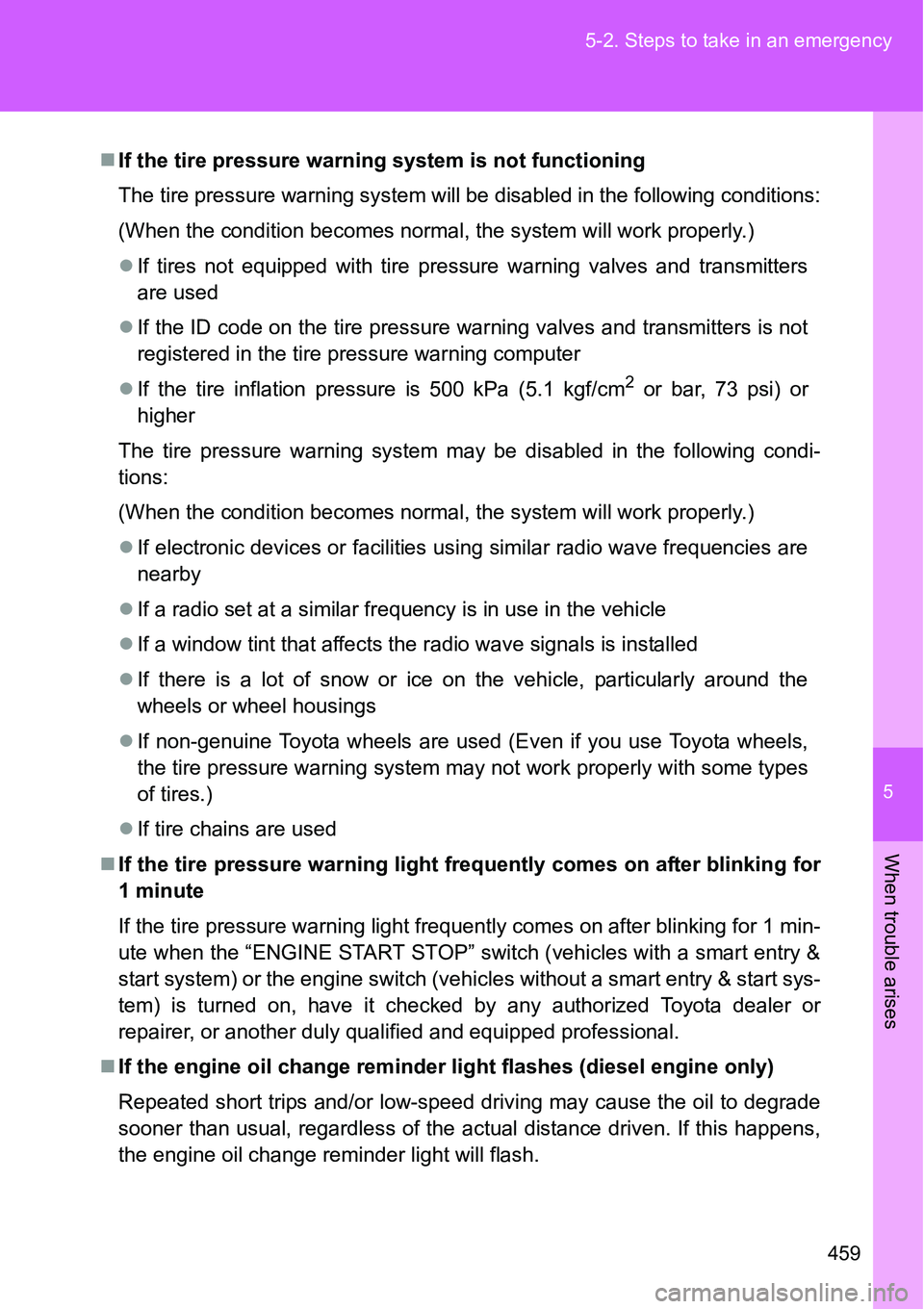Page 395 of 564

395
4-3. Do-it-yourself maintenance
4
Maintenance and care
Tire inflation pressure
Effects of incorrect tire inflation pressure
Driving with incorrect tire inflation pressure may result in the following:
Reduced fuel efficiency
Reduced driving comfort and tire life
Reduced safety
Damage to the drive train
If a tire needs frequent inflating, have it checked by any authorized Toyota
dealer or repairer, or another duly qualified and equipped professional.
Instructions for checking tire inflation pressure
When checking tire inflation pressure, observe the following:
Check only when the tires are cold.
If your vehicle has been parked for at least 3 hours or has not been
driven for more than 1.5 km or 1 mile, you will get an accurate cold tire
inflation pressure reading.
Always use a tire pressure gauge.
The appearance of the tire can be misleading. In addition, tire inflation
pressure that is even just a few pounds off can affect ride quality and
handling.
Do not reduce tire inflation pressure after driving. It is normal for tire infla-
tion pressure to be higher after driving.
Never exceed the vehicle capacity weight.
Passengers and luggage weight should be placed so that the vehicle is
balanced.
Make sure to maintain proper tire inflation pressure. Tire inflation
pressure should be checked at least once per month. However,
Toyota recommends that tire inflation pressure be checked once
every two weeks. (P. 535)
Page 396 of 564
396 4-3. Do-it-yourself maintenance
CAUTION
Proper inflation is critical to save tire performance
Keep your tires properly inflated. Otherwise, the following conditions may
occur and result in an accident causing death or serious injury:
Excessive wear
Uneven wear
Poor handling
Possibility of blowouts resulting from overheated tires
Poor sealing of the tire bead
Wheel deformation and/or tire separation
A greater possibility of tire damage from road hazards
NOTICE
When inspecting and adjusting tire inflation pressure
Be sure to put the tire valve caps back on.
Without the valve caps, dirt or moisture could get into the valve and cause
air leakage, which could result in an accident. If the caps are lost, replace
them as soon as possible.
Page 398 of 564

398 4-3. Do-it-yourself maintenance
When replacing wheels
The wheels of your vehicle are equipped with tire pressure warning valves
and transmitters that allow the tire pressure warning system to provide
advance warning in the event of a loss in tire inflation pressure. Whenever
wheels are replaced, tire pressure warning valves and transmitters must be
installed. (P. 385)
CAUTION
When replacing wheels
Do not use wheels that are a different size from those recommended in the
Owner’s Manual, as this may result in a loss of handling control.
Never use an inner tube in a leaking wheel which is designed for a tube-
less tire. Doing so may result in an accident, causing death or serious
injury.
When installing the wheel nuts
Never use oil or grease on the wheel bolts or wheel nuts.
Oil and grease may cause the wheel nuts to be excessively tightened,
leading to bolt or disc wheel damage. In addition, the oil or grease can
cause the wheel nuts to loosen and the wheel may fall off, causing an acci-
dent and resulting in death or serious injury. Remove any oil or grease
from the wheel bolts or wheel nuts.
Be sure to install the wheel nuts with
the tapered end facing inward. Install-
ing the nuts with the tapered end facing
outward can cause wheel to break and
eventually cause a wheel to come off
while driving, which could lead to an
accident resulting in death or serious
injury.
Tapered portion
Page 435 of 564

5When trouble arises
435
5-1. Essential information
Emergency flashers .......... 436
If your vehicle needs to
be towed ......................... 437
If you think something is
wrong .............................. 445
Fuel pump shut
off system ....................... 446
5-2. Steps to take in an
emergency
If a warning light turns
on or a warning buzzer
sounds... ........................ 447
If you have a flat tire
(vehicles with a spare
tire) ................................. 462
If you have a flat tire
(vehicles with an
emergency tire puncture
repair kit)......................... 475
If the engine will not
start ................................ 492
If the shift lever cannot be
shifted from P ................. 495
If you lose your keys ......... 496If the electronic key does
not operate properly ....... 497
If the battery is
discharged ...................... 501
If your vehicle
overheats ........................ 509
If you run out of fuel and
the engine stalls.............. 514
If the vehicle becomes
stuck ............................... 516
If your vehicle has to
be stopped in an
emergency ...................... 518
Page 445 of 564

5
445
5-1. Essential information
When trouble arises
If you think something is wrong
If you notice any of the following symptoms, your vehicle probably
needs adjustment or repair. Contact any authorized Toyota dealer or
repairer, or another duly qualified and equipped professional as
soon as possible.
Visible symptoms
Fluid leaks under the vehicle
(Water dripping from the air conditioning after use is normal.)
Flat-looking tires or uneven tire wear
High engine coolant temperature warning light flashes or
comes on
Low engine coolant temperature indicator comes on or does
not come on continuously
Audible symptoms
Changes in exhaust sound
Excessive tire squeal when cornering
Strange noises related to the suspension system
Pinging or other noises related to the engine
Operational symptoms
Engine missing, stumbling or running roughly
Appreciable loss of power
Vehicle pulls heavily to one side when braking
Vehicle pulls heavily to one side when driving on a level road
Loss of brake effectiveness, spongy feeling, pedal almost
touches the floor
Page 453 of 564

5
453 5-2. Steps to take in an emergency
When trouble arises
(Comes on)Engine oil change
reminder light (diesel
engine only)
Indicates that the engine
oil should be changed.
Comes on approximately
15000 km (9300 miles)
after the engine oil is
changed (and the oil main-
tenance data has been
reset).Check and change the
engine oil and oil filter by
any authorized Toyota
dealer or repairer, or
another duly qualified and
equipped professional. After
changing the engine oil, the
oil change system should
be reset. (P. 374)
Tire pressure warning
light
When the light comes on:
Low tire inflation pressure
such as
• Natural causes (P. 458)
• Flat tire (P. 462, 475)Adjust the tire inflation pres-
sure to the specified level.
The light will turn off after a
few minutes. In case the
light does not turn off even
if the tire inflation pressure
is adjusted, have the sys-
tem checked by any
authorized Toyota dealer
or repairer, or another duly
qualified and equipped
professional.
When the light comes on
after blinking for 1 minute:
Malfunction in the tire pres-
sure warning system
(P. 459)Have the system checked
by any authorized Toyota
dealer or repairer, or
another duly qualified and
equipped professional.
Warning lightWarning light/DetailsCorrection procedure
Page 458 of 564

458 5-2. Steps to take in an emergency
If the malfunction indicator lamp comes on while driving
For some models, the malfunction indicator lamp will come on if the fuel tank
becomes completely empty. If the fuel tank is empty, refuel the vehicle
immediately. The malfunction indicator lamp will go off after several trips.
If the malfunction indicator lamp does not go off, contact any authorized
Toyota dealer or repairer, or another duly qualified and equipped profes-
sional, as soon as possible.
Passenger detection sensor and passenger seat belt reminder
If luggage is placed on a passenger seat, the passenger detection sensor
may cause the warning light to flash even if a passenger is not sitting in
the seat.
If a cushion is placed on the seat, the sensor may not detect a passen-
ger, and the warning light may not operate properly.
When the tire pressure warning light comes on
Check the tire inflation pressure and adjust to the appropriate level. Pushing
the tire pressure warning reset switch will not turn off the tire pressure warn-
ing light.
The tire pressure warning light may come on due to natural causes
The tire pressure warning light may come on due to natural causes such as
natural air leaks and tire inflation pressure changes caused by temperature.
In this case, adjusting the tire inflation pressure will turn off the warning light
(after a few minutes).
When a tire is replaced with a spare tire
The compact spare tire is not equipped with a tire pressure warning valve
and transmitter. If a tire goes flat, the tire pressure warning light will not turn
off even though the flat tire has been replaced with the spare tire. Replace
the spare tire with the repaired tire and adjust the tire inflation pressure. The
tire pressure warning light will go off after a few minutes.
Page 459 of 564

5
459 5-2. Steps to take in an emergency
When trouble arises
If the tire pressure warning system is not functioning
The tire pressure warning system will be disabled in the following conditions:
(When the condition becomes normal, the system will work properly.)
If tires not equipped with tire pressure warning valves and transmitters
are used
If the ID code on the tire pressure warning valves and transmitters is not
registered in the tire pressure warning computer
If the tire inflation pressure is 500 kPa (5.1 kgf/cm
2 or bar, 73 psi) or
higher
The tire pressure warning system may be disabled in the following condi-
tions:
(When the condition becomes normal, the system will work properly.)
If electronic devices or facilities using similar radio wave frequencies are
nearby
If a radio set at a similar frequency is in use in the vehicle
If a window tint that affects the radio wave signals is installed
If there is a lot of snow or ice on the vehicle, particularly around the
wheels or wheel housings
If non-genuine Toyota wheels are used (Even if you use Toyota wheels,
the tire pressure warning system may not work properly with some types
of tires.)
If tire chains are used
If the tire pressure warning light frequently comes on after blinking for
1 minute
If the tire pressure warning light frequently comes on after blinking for 1 min-
ute when the “ENGINE START STOP” switch (vehicles with a smart entry &
start system) or the engine switch (vehicles without a smart entry & start sys-
tem) is turned on, have it checked by any authorized Toyota dealer or
repairer, or another duly qualified and equipped professional.
If the engine oil change reminder light flashes (diesel engine only)
Repeated short trips and/or low-speed driving may cause the oil to degrade
sooner than usual, regardless of the actual distance driven. If this happens,
the engine oil change reminder light will flash.